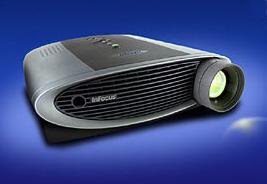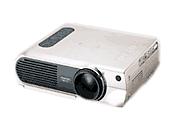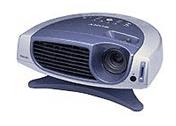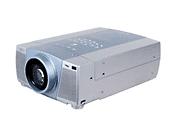Product Review - Fall 2001 Lineup of
Digital Projectors - A Visit to Projector People in Tampa, Florida - December, 2001
Stacey Spears
![]()
 |
InFocus LP530 - Single DLP - 2000 Lumens - $4,499 |
 |
Toshiba TLP-MT7 - 3 LCD - 1000 Lumens - $5,295 |
 |
Sony VPLHS1 Cineza - 3 LCD - 700 Lumens - $2,999 |
 |
Sanyo PLV-60HT - 3 LCD - 1200 Lumens - $4,649 |
Introduction
Hot on the heels of Cedia, I found
myself in Tampa, Florida (one day after Cedia to be exact). Upon arriving in
the state of absolute humidity, I was greeted at the airport by Jennifer and
Paul from Projector People. I had been corresponding with Jen for several
weeks prior to my visit.
Our first stop was a local sandwich shop located in the complex next to
projector people. Much to my delight, this shop stocked Zapps (http://www.zapps.com
) kettle style potato chips. This was a sign of good things to come (except
for that blasted humidity!)
Once we threw back our food, we headed next door to get the ball rolling. They
had a big welcome sign for me, with a conference room reserved that contained
a VERY large Stewart GrayHawk screen and lots of snacks.
I was given a quick tour and introduced to Rodney and Kelly. Kelly is Jen's
boss and the person responsible for Projector People's existence. Projector
people is actually part of a larger company that sells displays for areas
outside of home theater.
Everyone I met was extremely nice, and they fed me well during my 3-day visit.
This includes southern sweet tea, BBQ pork sandwiches, and Krispy Kreme
doughnuts. However, I did not get the promised gator bites. (Deep fried and
crispy as God intended.)
PP had put together five different digital display devices. The goal was to
have one of each type of technology, but they were unable to obtain a D-ILA.
The fifth display, a 3-chip DLP required a 240VAC line so we were unable to
take a look at it.
I will say now that while digital displays have come along way and have many
benefits, in absolute terms, they do not match the best that is available
today from CRT. They are better in some ways like light output, but in terms
of absolute picture quality a color filtered G90 (with a special green filter
element from USPL) is still the best display device on the planet. Of course
this is on a controlled 80" wide 16x9 screen. For most people, they would
never think to spend $42,000 for G90 to only view it on a small 80" wide
screen. And don't even talk about the horrendous setup procedure that every
CRT projector requires.
For those who care more about low price and a bright picture (can illuminate a
really large screen), then a digital display will probably fit you well. A
digital display is also easier to set up and maintain. No convergence
required, though many 3-chip devices still have convergence errors, but there
is nothing you an do about it. You just put it on a coffee table, connect it
to your DVD player, turn it on, zoom and focus, and you are watching a movie.
The following product remarks are not intended as a full review. I was not
equipped with all of the necessary tools to do an accurate evaluation.
Before looking at each projector, I
set sharpness, brightness, and contrast. I used Avia to see if the white and
black levels were properly being displayed. We used a Sony N700S progressive
scan DVD player on all of the displays.
InFocus LP530
The 530 was the first display we tested. This is a single chip DLP that
includes Sage (Faroudja) technology. It is specifically equipped with the
FLI2200 chip.
The 530 is limited to DVI, S-Video, and Composite video inputs. There is no
way to feed this display a progressive scan image via component video. But, it
is equipped with the Sage chip (DCDi), so deinterlacing should not be an
issue.
Overall I found the on-screen menus to be a bit slow. You will notice them
when adjusting the video settings or changing volume. Overall not a big deal.
When setting contrast using the pattern on Avia, I found it will clip white if
you set the contrast to 67 or above. I settled on 60 as the best value. I
ended up with brightness set to 48.
I set the internal sharpness control at soft and med-soft. At either setting,
the 6.75 MHz pattern on Avia was a gray blur meaning that it can't resolve the
full detail on DVD. This could be the video decoder inside of the display.
Perhaps it will resolve all of this when using the DVI input (this is the new
input for connecting to an HDTV signal from your satellite dish).
When sharpness was set to soft, there was no moiré on the Avia 200 TVL test
pattern. When set to med-soft, I could see moiré.
The 530 has three gamma modes, film, video, and PC. (Gamma controls the
brightness curve.) I was also able to locate the RGB gain controls for setting
gray scale, but I could not locate the bias controls. Perhaps these are
located in a service menu. Without having the service manual, I don't know. If
you do not have full access to bias and gain controls, then you cannot set
grayscale.
When looking at a geometry pattern on Avia, I could see a slight amount of
chromatic aberration towards the edges of the screen (white lines would have
red, green, or blue edges rather than just being white). This is a result of
the lens element on the 530. Good lenses are very expensive.
My biggest gripe with this DLP - and many other DLPs for that matter - is the
light leaking around the outside of the panel. You can see this light all
around the outside of the image. If you are able to place black velvet or a
similar material along the border of your screen, this should not be a
problem. The left hand side really had a lot of light leaking around it.
Deinterlacing tests
WHQL Film 1.
Passed
WHQL Mixed
Failed because it took >3 frames to recover (it took 10 frames); no combing,
which is good.
WHQL Chapter 1.
Passed
WHQL Chatper 2
Passed
Motion Adaptive.
Passed
Big Lebowski
Passed
More Tales
Passed. Strange texture in image during pans. Looks like some type of noise or
posterization. This is similar to the diamond type pattern you see when using
a poorly shielded S-Video cable. It could be chroma leaking into luma via
radation.
Apollo 13
Passed
The cross color suppressor inside of the Sage chip is turned on with the
S-Video input, so you get flicker on heavily saturated colors. I hope this can
be fixed with some type of firmware upgrade. I will inform Sage of this
setting within the 530.
Super Speedway
Passed
The Abyss
Failed. 7 combs.
Chroma resolution.
Pb
Gone by 2 MHz.
Pr
Gone by 2 MHz.
These values are typical of S-Video. If this projector had YPbPr inputs, you
would get better color resolution.
Conclusion
If you can frame some type of blackout material around the border of your
screen, the 530 would make a nice display device. It has film mode
deinterlacing provided by Sage, so you can use a small interlaced DVD player
like a Panasonic RV-31 and you would have a nice little home theater.
One last comment, I did see rainbows on this single chip DLP. It is most
noticeable when the background is dark and you have bright objects on-screen.
Rainbows with DLP is universal, but not everyone notices it.
Toshiba TLP-MT7
The MT7 uses a 3-chip 16x9 LCD panel with a fixed resolution of 1280x720. It
will accept 480i, 480p, 720p, and 1080i. All rates that are not 720p are
scaled either up or down to 720p.
There is a 15-pin D-Sub for the component input. Do not use this projector
without a progressive scan DVD player. Its built-in deinterlacer does not
offer film mode. On the plus side, it does have a motion-adaptive deinterlacer
for video based content.
Overall the fan noise was the quietist of all the projectors I tested here. In
fact, it was surprisingly quiet for a digital display.
YPbPr input default contrast was clipping the top end. I tried pulling
contrast down, but I never was able to bring back the top end of white. The
black bar stripe on Avia was also gone on YPbPr. I had to pull the brightness
up to +6 to get any stripe at all.
I ended up setting contrast at +3 and brightness to -7. Sharpness was adjusted
to -2.
When looking at the Avia 200TVL pattern, it was a gray patch instead of
distinct lines. This display is not capable of resolving all of the detail of
DVD when fed an interlaced signal.
While the 6.75 MHz pattern was gray, everything else was extra crispy. There
were halos around horizontal lines (all four in Avia). Circles and diagonals
also had halos. Even with sharpness set at -2, the halos were still all around
the four horizontal lines. Way too much enhancement using S-Video input!
All the moiré and aliasing went away the sharpness was set to -3.
When looking at the bounce pattern on Avia, the image shifted right a bit when
it hit the low APL window. This suggests a clamping issue. Not uncommon. You
would notice this shift in films as there are quick transition from dark to
light.
I was unable to find any H/V size or position adjustment in video mode
(non-PC).
There was a slight amount of posterization that could be seen in the flesh
tones. I used chapter 13 of Apollo 13 for this. I do not see this when looking
at the Sanyo PLV-60 or Sony 10HT.
Chroma sweep
YC
Pb fades out after 2 MHz and is gone after 2.5 MHz. Pr is the same.
YPbPr
Pb and Pr both display the full chroma resolution.
Conclusion
I was unable to get the top (white)
and bottom (black) end of the video signal. This clipping may be responsible
for the posterization errors I found. At this price point, I would steer
towards the Sony 10HT or Sanyo PLV 60 as they both deliver a better picture.
Sony VPLHS1 Cineza
I was excited to get to see the Sony Cineza. It was officially introduced just
a couple of days earlier at Cedia during the Sony press conference. It is
their ultra entry level LCD display that offers both vertical and horizontal
keystone correction. You can place it off to the side of your room and correct
for that location. Would I ever do this? NO! But the choice is there if you
have a room that just absolutely requires you to put the projector off to the
side.
The Cineza uses a lower resolution 800x600 panel, which really can't deliver
the full vertical resolution of anamoprhic DVD. Its fill factor is also low,
which requires you sit a bit further back so that you do not see the pixel
structure or screen door effect.
I ended up setting contrast to 80 and brightness to 35. The brightness is set
too high out of the box.
This display has an S-Video input and a special component input, which
requires an additional cable, not provided. I only looked at the S-Video
input. If you get this display, get that cable!
While it can accept 480i, 480p, 720p, and 1080i, it will never deliver the
full vertical resolution of any format above 480i. This goes for all 800x600
display devices, not just the Cineza.
There was a faint amount of detail at 6.75 MHz on the S-Video input.
It does have H/V position controls, but no size controls in the user menu.
There were no clamping problems when looking at the bounce pattern on Avia.
It does offer a squeeze mode for anamoprhic DVD , but no zoom mode for non-anamoprhnic
DVDs.
Its video deinterlacing is NOT motion-adaptive. This means you will have a
VERY soft image unless you feed it 480p. Not sure why they did not include
their DRC technology, which is a bare minimum in my opinion.
Chroma resolution on YC is as expected, rolled-off.
Unlike the Toshiba, I did not see any posterization problems on the Cineza.
The keystone reshapes the image, but you are left with a visible border around
the outside, and the on-screen menus are not corrected. (They match the
background image, strange!)
Conclusion
If you are looking at the Cineza for a
low cost home theater projector, I think you can do better with a different
model. You can get something like the NEC LT150 around the same price, and it
delivers a much better image. This projector is more suited for low resolution
applications like a PS2 game console for your kid's room. Since it does not
offer motion-adaptive deinterlacing for video, I can't even recommend it for
football games on Sunday.
Sanyo PLV-60HT
What can I say; it is a Sony 10HT on steroids. Well, that might not be
entirely correct as it has a Sanyo menu system. It does use the Sony 3-chip
16x9 LCD panels and Sony's DRC motion-adaptive deinterlacing.
Sanyo has moved the inputs to the back of the display, where I feel they
belong. It uses superior BNC connectors on the component inputs, while the
10HT uses RCA jacks. It also has a remote control focus and lens shifting
adjustment. So, you shift the lens instead of using digital keystone to
correct for slight location variations. By having them via remote control, you
can put your nose to the screen and get focus done properly. Is it worth the
added cost? Maybe. It depends on how critical you are. With lens shift, not
only is the keystone correction made, but the top and bottom will both be in
focus.
While you can get away with playing video games and watching sporting evens on
the interlaced inputs, you must use a progressive scan DVD player or HD set
top box to get the most of this display.
The YC chroma response is typical and gone by 2.5 MHz. The YPbPr chroma
response is flat as a ruler.
I saw not hint of posterization while watching the Sanyo. It was also able to
deliver above white and below black without clipping. Color accuracy also
seemed dead on.
PP also dug up a 10HT so we could check the claim of double the contrast
ratio. I did not use a full on/off test for contrast. I used the checkerboard
pattern on Avia. You really want to measure both ways. The checkerboard will
take into account the lens elements and represents a worse case contrast. I
measured the 10HT at 68:1 and the PLV-60 at 101:1. The 10HT usually delivers
around 140-160:1 full on/off. So, there you are. The PLV-60 does have more
contrast than the 10HT.
I saw no clamping problems when looking at the bounce pattern on Avia.
The Sanyo is using a Pixel Works
scaler, which is as good as it gets. It is at least equal to the scaler made
by Genesis used in most external video processors like Faruodja. If you can
feed a 480p into this display, there is no need for an external scaler. This
display has full aspect ratio control so you are set with anamorphic DVDs.
I saw no chromatic aberration on the edges, which suggests a very good lens.
Conclusion
This was by far the best display of
the bunch, and if I had to choose between the four above, this is a
no-brainer. Is it better than CRT? No, but I could live with it.
I looked at the four displays over the course of two days. I looked at two
projectors per day spending about 4 hours with each.
While spending several hours looking
at the projectors, Kelly, Jen's boss, provided us with some tasty food. I want
to thank Kelly, Jen, and PP for dinner each night. They are the nicest bunch
of people, and Jen is almost as funny (sarcastic might be more correct) as I
am. (For those who know me.) I had a great time and would be happy to show
them around if they ever make it up to the Pacific Northwest.
- Stacey Spears -
![]()
© Copyright 2001 Secrets of Home Theater & High Fidelity
Return to Table of Contents for this Issue.

